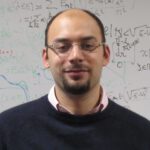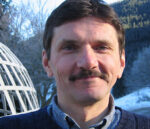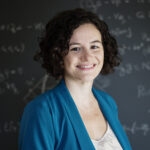2025/26
 Title: A geometric choice of asymptotically Euclidean coordinates via STCMC-foliations
Title: A geometric choice of asymptotically Euclidean coordinates via STCMC-foliations
Abstract: Asymptotically Euclidean initial data sets (IDS) in General Relativity model instants in time for isolated systems. In this talk, we show that an IDS is asymptotically Euclidean if it admits a cover by closed hypersurfaces of constant spacetime mean curvature (STCMC), provided these hypersurfaces satisfy certain geometric estimates, some weak foliation properties, and each surface exhibits generalized stability. Building on the work of Cederbaum and Sakovich (2021), which established that every asymptotically Euclidean IDS has a unique STCMC foliation, we conclude that the existence of such a foliation characterizes asymptotically Euclidean IDS. Furthermore, we explore the connections to the center of mass and show why these coordinates seem well-adapted to describe this concept. This is joint work with O. Vičánek Martínez.
Video to appear
 Title: Non-linear waves and time-periodicity
Title: Non-linear waves and time-periodicity
Abstract: I will give an overview talk concerning the possible existence and stability of solutions to non-linear wave equations which are periodic in time. Such solutions can arise in a variety of mathematical models, from fluid dynamics, elasticity, and general relativity, where in particular, there were investigated numerically by Maliborski and Rostworowski (2013) for the Einstein-scalar-field model in spherically symmetry near the Anti-de-Sitter spacetime. I will start the presentation with some reminder concerning the linear wave equation on Anti-de-Sitter before presenting some results and methods for semi-linear wave equations. In a second part, I will describe a recent construction of special coordinates for 1+1 Lorentzian metric on ℝx𝕊1 with time-periodic coefficients, which is expected to be an essential step to extend the previous results to quasi-linear wave equations. This is joint work with Athanasios Chatzikaleas (National and Kapodistrian University of Athens ).
 Title: Progress towards the BKL Proposal
Title: Progress towards the BKL Proposal
Abstract: Around 50 years ago, physicists Belinski, Khalatnikov and Lifshitz provided heuristics describing the behaviour of near-singularity solutions to the Einstein equations as spacelike, local and oscillatory. Vaguely speaking, they suggest that dynamics corresponding to different spatial points on the singularity decouple and resemble a chaotic cascade of so-called “Kasner epochs”. In this talk, we present a mathematical formulation of this “BKL Conjecture” and progress towards the conjecture in the case of Gowdy symmetric spacetimes.
2024/25
 Title: Hyperbolic Mass in 2+1 Dimensions
Title: Hyperbolic Mass in 2+1 Dimensions
Abstract: Solutions to general relativity with a negative cosmological constant have received significant attention due to the conjectured AdS/CFT correspondence, a particularly well-understood example of which is exhibited in 2+1 dimensions.
I will review known vacuum solutions to general relativity with a negative cosmological constant in 2+1 dimensions and discuss the difficulties in defining mass, which are resolved via minimisation using a positive energy theorem. I will present a gluing theorem for vacuum time-symmetric general-relativistic initial data sets in two spatial dimensions. By gluing two given time-symmetric vacuum initial data sets at conformal infinity, we obtain new time-symmetric vacuum initial data sets. I will sketch the derivation of the mass formulae of the resulting manifolds. Our gluing theorem yields complete manifolds with any mass aspect function, which are smooth except for one conical singularity. Based on joint work with P. T. Chruściel.
 Title: Null geometry and applications to existence of spacetimes
Title: Null geometry and applications to existence of spacetimes
Abstract: Non-null hypersurfaces can be easily viewed as geometric objects detached from the spacetime where they are embedded. This process of “detachment” is more complicated in the case of null hypersurfaces. In this talk I will introduce the notion of “null manifold”, together with related concepts such as “ruled null manifold” or “metric hypersurface data”, as a way to study null hypersurfaces from a fully detached point of view. With this framework at hand, I will then discuss three applications related to existence of spacetimes. Specifically, I will present a detached version of the characteristic initial value problem, a general analysis of transverse expansions across a null hypersurface and an existence and asymptotic uniqueness result of Λ-vacuum spacetimes from data on a (detached) non-degenerate Killing horizon. The three applications are joint work with Gabriel Sánchez Pérez.
This talk was part of the hybrid workshop “Geometry, Analysis, and Physics in Lorentzian signature” at BIRS-IMAG in Granada, Spain.
 Title: Systolic inequalities and the Horowitz-Myers conjecture
Title: Systolic inequalities and the Horowitz-Myers conjecture
Abstract: I will discuss joint work with Pei-Ken Hung on the Horowitz-Myers conjecture in dimension at most 7. Our approach relies on a new geometric inequality. For a Riemannian metric on B2xTn-2 with scalar curvature at least -n(n-1), this inequality relates the systole of the boundary to the mean curvature of the boundary.
 Title: Optimal Transport in Lorentzian Geometry
Title: Optimal Transport in Lorentzian Geometry
Abstract: In recent years the theory of optimal transportation has made an impact on Lorentzian geometry, mainly through synthetic definitions of timelike Ricci curvature bounds for Lorentzian manifolds and Lorentzian length spaces. But there are also other aspects of Lorentzian optimal transport relevant to general relativity. I will give an overview of the basic ideas of Lorentzian optimal transport and recent results. Further I will indicate some open problems in this context.
 Title: Gluing small black holes along timelike geodesics
Title: Gluing small black holes along timelike geodesics
Abstract: Suppose we are given a globally hyperbolic spacetime (M,g) solving the Einstein vacuum equations, and a timelike geodesic in M. I will explain how to construct, on any compact subset of M, a solution geps of the Einstein vacuum equations which is approximately equal to g far from the geodesic but near any point along the geodesic approximately equal to the metric of a Kerr black hole with masseps. As an application, we can construct spacetimes which describe the merger of a very light black hole with a unit mass black hole, followed by the relaxation of the resulting single black hole to its equilibrium (Kerr or Kerr-de Sitter) state.
 Title: Einstein manifolds with boundary
Title: Einstein manifolds with boundary
Abstract: We will talk about existence of Einstein metrics on manifolds with boundary, while prescribing the induced conformal metric and mean curvature of the boundary. In dimension 3, this becomes the existence of conformal embeddings of surfaces into constant sectional curvature space forms, with prescribed mean curvature. We will show existence of such conformal embeddings near generic Einstein background. We will also discuss the existence question in higher dimensions, where things become more subtle and a non-degenerate boundary condition is used to construct metrics with nonpositive Einstein constant.
 Title: The interplay of mathematics and numerics in understanding naked singularity formation in critical collapse
Title: The interplay of mathematics and numerics in understanding naked singularity formation in critical collapse
Abstract: I will give an overview of numerical evidence that codimension one-sets of smooth initial data for matter coupled to GR form naked singularities – from scalar fields and fluids in spherical symmetry, where the evidence is strong, to vacuum GR, where the evidence is still confusing, but at least now beginning to be agreed by independent codes. Can one hope to prove some form of this naked singularity conjecture? In the last ten years or so, there has been considerable mathematical progress on the existence and stability of smooth self-similar blowup solutions in dispersive PDEs, and on naked singularity formation in GR. I will highlight some of these papers that particularly interest me as steps on the way to a future proof of naked singularity formation from codimension-one smooth initial data.
2023/24
 Title: BMS-supertranslation charges at the critical sets of null infinity
Title: BMS-supertranslation charges at the critical sets of null infinity
Abstract: For asymptotically flat spacetimes, a conjecture by Strominger states that asymptotic BMS-supertranslations and their associated charges at past null infinity can be related to those at future null infinity via an antipodal map at spatial infinity. We analyse the validity of this conjecture using Friedrich’s formulation of spatial infinity, which gives rise to a regular initial value problem for the conformal field equations at spatial infinity. We show that for a generic class of asymptotically Euclidean and regular initial data, BMS-supertranslation charges are not well-defined at the critical sets where null infinity meets spatial infinity unless the initial data satisfies an extra regularity condition. We also show that given initial data that satisfy the regularity condition, BMS-supertranslation charges at the critical sets are fully determined by the initial data and that the relation between the charges at past null infinity and those at future null infinity directly follows from our regularity condition. This is joint work with Mariem Magdy Ali Mohamed and Kartik Prabhu.
Video to appear
 Title: Retiring the third law of black hole thermodynamics
Title: Retiring the third law of black hole thermodynamics
Abstract: Extremal black holes are special types of black holes which have exactly zero temperature. I will present a proof that extremal black holes form in finite time in gravitational collapse of charged matter. In particular, this construction provides a definitive disproof of the “third law” of black hole thermodynamics. We also show that extremal black holes take on a central role in gravitational collapse, giving rise to a new conjectural picture of “extremal critical collapse.” This is joint work with Ryan Unger (Princeton).
 Title: The Teukolsky equation on Kerr in the full subextremal range
Title: The Teukolsky equation on Kerr in the full subextremal range
Abstract: The Teukolsky equation is one of the fundamental equations governing linear gravitational perturbations of the Kerr black hole family as solutions to the vacuum Einstein equations. I will discuss joint work with Yakov Shlapentokh-Rothman (Toronto), where we show that solutions arising from suitably regular initial data decay inverse polynomially in time. Our proof holds for the entire subextremal range of Kerr black hole parameters (|a| < M).
No video available
 Title: Squeezing a fixed amount of gravitational energy to arbitrarily small scales, in U(1) symmetry
Title: Squeezing a fixed amount of gravitational energy to arbitrarily small scales, in U(1) symmetry
Abstract: We discuss a construction of polarized U(1) space-times of a “fixed size”, where the initial data contains a given amount η>0 of incoming gravitational energy which is allowed to be supported at arbitrarily small scales, without affecting the time of existence. More specialized examples can be constructed where any chosen fraction of this initial incoming energy can stay focused along a null geodesic, in the U(1) picture. We discuss the relationship of this result with one direction of Thorne’s hoop conjecture. The work relies on a special structure of the Einstein equations in this symmetry class, a new re-scaling of the equations and large-time control, along with a new local Klainerman-Sobolev estimate. Time permitting, some comparisons of the result and the methods with large-data constructions for the Einstein equations over the last decade will also be presented. This is joint work with Nathan Carruth.
 Title: How minimal hypersurface and MOTS singularities affect relativity theorems
Title: How minimal hypersurface and MOTS singularities affect relativity theorems
Abstract: Some theorems in relativity work directly only in low dimensions because of the possibility of singularities in area minimizing hypersurfaces and MOTS. These include both Riemannian and spacetime positive mass theorems as well as the Riemannian Penrose inequality. In some cases the singularities are relatively easy to work around and in others they present significant problems to overcome. This will be a general lecture which will attempt to give perspective and more clarity to this issue.
This was a special lecture streamed from the ESI conference “Mathematical Relativity: Past, Present, Future” on the occasion of the 100th birthday of Yvonne Choquet-Bruhat on the 29th of December 2023. Watch recording.
2022/23
Title: High frequency solutions in general relativity and the Burnett’s conjecture
Abstract: In this talk, I will review some works in collaboration with Jonathan Luk on the behaviour of high frequency solutions to the Einstein equations. In the eighties, the physicist Burnett conjectured that the adherence of the solutions to the Einstein equations, converging strongly at the level of the metric, and with boudedness assumptions at the level of derivative of the metric, are the solutions to the Einstein-massless Vlasov equations. I will focus on the resolution of this conjecture with the additionnal assumption of a translation symmetry, and explain how to approximate a solution to the Einstein-Vlasov equations by vacuum solutions.
No video available
 Title: A Green’s function proof of the positive mass theorem and related topics
Title: A Green’s function proof of the positive mass theorem and related topics
Abstract: In this talk, we will explore the role of harmonic and p-harmonic functions in establishing fundamental geometric inequalities in mathematical relativity, such as the positive mass theorem and the Penrose inequality. We will introduce new monotonicity formulas along the level flow of these functions, which provide simple proofs for these inequalities. Additionally, we will discuss how these formulas can be used to characterize the nonnegativity of the scalar curvature, suggesting a synthetic notion of this concept applicable in non-smooth contexts.
 Title: Abstract Lorentzian metric spaces and their Gromov-Hausdorff convergence
Title: Abstract Lorentzian metric spaces and their Gromov-Hausdorff convergence
Abstract: A definition for `bounded Lorentzian metric space’ is presented and discussed. This is an abstract notion of Lorentzian metric space that is sufficiently general to comprise compact causally convex subsets of globally hyperbolic (smooth) spacetimes, and causets.
It is shown that a generalization of the Gromov-Hausdorff distance and convergence can be applied to these spaces. Furthermore, two additional axioms of timelike connectedness and existence of maximizers, which are stable under GH-convergence, lead to suitable notions of Lorentzian pre-length and length spaces. Similarly, sectional curvature bounds stable under GH-convergence can be introduced. A (pre)compactness theorem is also mentioned and its limitations are discussed. Talk based on joint work with Stefan Suhr (Bochum).
 Title: Wave equations in subextremal Kerr-de Sitter spacetimes
Title: Wave equations in subextremal Kerr-de Sitter spacetimes
Abstract: In 2013, Vasy proved that solutions to linear wave equations in Kerr-de Sitter spacetimes have asymptotic expansions in quasinormal modes up to an exponentially decaying term, assuming the angular momentum of the black hole satisfies certain bounds. This was the first step towards the proof of non-linear stability for slowly rotating Kerr-de Sitter black holes by Hintz and Vasy in 2018. In this talk, we extend Vasy’s result to the full subextremal range of Kerr-de Sitter spacetimes, by removing the restrictions on the angular momentum of the black hole. The proof is based on a new Fredholm setup and a new analysis of the trapping of photons around a Kerr-de Sitter black hole. This is joint work with Andras Vasy.
 Title: A nonsmooth approach to Einstein’s theory of gravity
Title: A nonsmooth approach to Einstein’s theory of gravity
Abstract: While Einstein’s theory of gravity is formulated in a smooth setting, the celebrated singularity theorems of Hawking and Penrose describe many physical situations in which this smoothness must eventually breakdown. In positive-definite signature, there is a highly successful theory of metric and metric-measure geometry which includes Riemannian manifolds as a special case, but permits the extraction of nonsmooth limits under dimension and curvature bounds analogous to the energy conditions in relativity: here sectional curvature is reformulated through triangle comparison, while Ricci curvature is reformulated using entropic convexity along geodesics of probability measures. This lecture explores recent progress in the development of an analogous theory in Lorentzian signature, whose ultimate goal is to provide a nonsmooth theory of gravity.
 Title: The nonlinear stability of Kerr for small angular momentum
Title: The nonlinear stability of Kerr for small angular momentum
Abstract: I will introduce the celebrated black hole stability conjecture according to which the Kerr family of metrics are stable as solutions to the Einstein vacuum equations of general relativity. I will then discuss the history of this problem, including a recent work on the resolution of the black hole stability conjecture for small angular momentum.
 Title: Relativistic elasticity and compactness bounds
Title: Relativistic elasticity and compactness bounds
Abstract: After reviewing the basics of relativistic elasticity theory, I will introduce a general framework to study spherically symmetric self-gravitating elastic bodies systematically within general relativity, and apply it to investigate compactness bounds in this context.
Title: A quasi-local view of black hole mergers
Abstract: In this talk I will summarize recent progress and open mathematical problems in understanding black hole mergers quasi-locally, i.e. by using marginally trapped surfaces instead of event horizons.
2021/22
Title: Uniqueness of large area-constrained Willmore spheres in initial data sets
of large area-constrained Willmore spheres in initial data sets
Abstract: The Hawking mass of an area-constrained Willmore sphere is a useful quasi-local measure for the strength of the gravitational field of an initial data set for the Einstein field equations. If the scalar curvature satisfies certain asymptotic assumptions, the asymptotic region of such an initial data set is foliated by large area-constrained Willmore spheres with non-negative Hawking mass. It has been conjectured that these are the only such spheres. In this talk, I will present a proof of this conjecture for all large area-constrained Willmore spheres with non-negative Hawking mass and outer radius less than the logarithm of the inner radius. This is joint work with Michael Eichmair, Jan Metzger, and Felix Schulze.
 Title: Stability of AVTD Behavior for Polarized T^2-Symmetric Space-Times
Title: Stability of AVTD Behavior for Polarized T^2-Symmetric Space-Times
Abstract: One of the most effective tools for proving that Strong Cosmic Censorship holds for a family of cosmological solutions of Einstein’s equations is to verify that these solutions all exhibit Asymptotically Velocity Term Dominated (AVTD) behavior in a neighborhood of their Big Bang singularities. After presenting some background history of known results and conjectures concerning the behavior of the gravitational field near the Big Bang in cosmological solutions of Einstein’s equations, we discuss recent work with Ellery Ames, Florian Beyer, and Todd Oliynyk in which we prove that polarized T^2-Symmetric vacuum solutions in a neighborhood of Kasner solutions all exhibit AVTD behavior close to the initial singularity. We also discuss our very recent extension of these results to the case of non-vanishing cosmological constant.
 Title: Towards a Spacetime Intrinsic Flat Convergence
Title: Towards a Spacetime Intrinsic Flat Convergence
Abstract: In order to define a spacetime intrinsc flat convergence, Carlos Vega and I defined the null distance to convert spacetimes endowed with regular cosmological times into metric spaces. Currently Anna Sakovich and I have been exploring the properties of these metric spaces. We can prove that one can recover the causal structure from the null distance and the cosmological time. We can
prove that a distance-preserving time-preserving bijection between the spacetimes endowed with a null distance is in fact a Lorentzian isometry under suitable conditions. Next we will prove there are
biLipschitz charts so that we may view the spacetimes endowed with the null distance as integral current spaces. This allows us to rigorously define the spacetime intrinsic flat convergence for
spacetimes that arise as the future maximal developments of initial
data sets. For more information about intrinsic flat convergence see https://sites.google.com/site/intrinsicflatconvergence/
 Title: The Memory Effect and Infrared Divergences
Title: The Memory Effect and Infrared Divergences
Abstract: The “memory effect” is the permanent relative displacement of test particles after the passage of gravitational radiation. It is associated with both the propagation of massive bodies out to timelike infinity (“ordinary memory”) or the propagation of radiation out to null infinity (“null memory”). The memory effect can be characterized by the failure of the shear tensor at order 1/r to return to zero at late times, even though it is “pure gauge.” Closely analogous effects occur in electromagnetism, where the vector potential at order 1/r fails to return to zero even though it is “pure gauge.” In both cases, the Fourier transform of the radiative field has divergent behavior at low frequencies. This gives rise to infrared divergences (i.e., infinite numbers of “soft” gravitons/photons) in the quantum field theory description if one attempts to describe these states as vectors in the usual Fock Hilbert space representation. To obtain a mathematically sensible quantum scattering theory, one must allow states with nonvanishing memory in the “in” and “out” Hilbert spaces. An elegant solution to this problem in massive quantum electrodynamics was given by Kulish and Fadeev, who constructed a Hilbert space of incoming/outgoing charged particle states that are “dressed” with radiative fields of corresponding memory, so as to yield vanishing large gauge charges at spatial infinity. However, we show that this type of construction fails in quantum gravity. The primary underlying reason is that the “dressing” contributes to null memory, thereby invalidating the construction of eigenstates of large gauge charges. In quantum gravity, there does not appear to be any choice of (separable) Hilbert space of incoming/outgoing states that can accommodate all scattering states. Thus, we argue that scattering should be described at the level of algebraic incoming/outgoing states rather than attempting to artificially restrict states to a particular Hilbert space.
 Title: Global Stability of Spacetimes with Supersymmetric Compactifications
Title: Global Stability of Spacetimes with Supersymmetric Compactifications
Abstract: Spacetimes with compact directions which have special holonomy, such as Calabi-Yau spaces, play an important role in supergravity and string theory. In this talk I will discuss a recent work with Lars Andersson, Pieter Blue and Shing-Tung Yau, where we show the global, nonlinear stability a spacetime which is a cartesian product of a high dimensional Minkowski space with a compact Ricci flat internal space with special holonomy. This stability result is related to a conjecture of Penrose concerning the validity of string theory. Our proof uses the intersection of methods for quasilinear wave and Klein-Gordon equations, and so towards the end of the talk I will also comment more generally on coupled wave–Klein-Gordon equations.
 Title: On the discrete Dirac spectrum of a point electron in the zero-gravity Kerr-Newman spacetime
Title: On the discrete Dirac spectrum of a point electron in the zero-gravity Kerr-Newman spacetime
Abstract: In relativistic quantum mechanics, the discrete spectrum of the Dirac hamiltonian with a Coulomb potential famously agrees with Sommerfeld’s fine structure formula for the hydrogen atom. In the Coulomb approximation, the proton is assumed to only have a positive electric charge. However, the physical proton also appears to have a magnetic moment which yields a hyperfine structure of the hydrogen atom that’s normally computed perturbatively. Aiming towards a non-perturbative approach, Pekeris in 1987 proposed taking the Kerr-Newman spacetime with its ring singularity as a source for the proton’s electric charge and magnetic moment. Given the proton’s mass and electric charge, the resulting Kerr-Newman spacetime lies well within the naked singularity sector which possess closed timelike loops. In 2014 Tahvildar-Zadeh showed that the zero-gravity limit of the Kerr-Newman spacetime (zGKN) produces a flat but topologically nontrivial spacetime that’s no longer plagued by closed timelike loops. In 2015 Tahvildar-Zadeh and Kiessling studied the hydrogen problem with Dirac’s equation on the zGKN spacetime and found that the hamiltonian is essentially self-adjoint and contains a nonempty discrete spectrum. In this talk, we show how their ideas can be extended to classify the discrete spectrum completely and relate it back to the known hydrogenic Dirac spectrum but yielding hyperfine-like and Lamb shift-like effects.
 Title: The characteristic gluing problem of general relativity
Title: The characteristic gluing problem of general relativity
Abstract: In this talk we introduce and solve the characteristic gluing problem for the Einstein vacuum equations. We prove that obstructions to characteristic gluing come from an infinite-dimensional space of conservation laws along null hypersurfaces for the linearized equations at Minkowski. We show that this obstruction space splits into an infinite-dimensional space of gauge-dependent charges and a 10-dimensional space of gauge-invariant charges. We identify the 10 gauge-invariant charges to be related to the energy, linear momentum, angular momentum and center-of-mass of the spacetime. Based on this identification, we explain how to characteristically glue a given spacetime to a suitably chosen Kerr black hole spacetime. As corollary we get an alternative proof of the Corvino-Schoen spacelike gluing to Kerr. Moreover, we apply our characteristic gluing method to localise characteristic initial data along null hypersurfaces. In particular, this yields a new proof of the Carlotto-Schoen spacelike localization where our method yields no loss of decay, thus resolving an open problem in this direction. We also outline further applications. This is joint work with S. Aretakis (Toronto) and I. Rodnianski (Princeton).
 Title: Singularity theorems in low regularity
Title: Singularity theorems in low regularity
Abstract: The singularity theorems of R. Penrose and S. Hawking from the 1960s show that a spacetime satisfying certain physically reasonable curvature and causality conditions cannot be causal geodesically complete. Despite their great success these classical theorems still have some drawbacks, one of them being that they require smoothness of the metric while in many physical models the metric is less regular. In my talk I will present work on singularity theorems based on distributional energy conditions for metrics that are merely continuously differentiable – a regularity where one still has existence but not uniqueness for solutions of the geodesic equation. We will see that an approximation-based approach to the low-regularity issue is closely linked to establishing singularity theorems under weakened energy conditions and while the improvements necessary are still entirely straightforward in the present case, attempting to lower the regularity further would require some new methods.
 Title: The black hole stability problem in general relativity
Title: The black hole stability problem in general relativity
Abstract: I will review the current status of the black hole stability problem in general relativity and discuss joint work Holzegel, Rodnianski and Taylor.
2020/21
 Title: The instability of Anti-de Sitter spacetime for the Einstein-scalar field system
Title: The instability of Anti-de Sitter spacetime for the Einstein-scalar field system
Abstract: The AdS instability conjecture provides an example of weak turbulence appearing in the dynamics of the Einstein equations in the presence of a negative cosmological constant. The conjecture claims the existence of arbitrarily small perturbations to the initial data of Anti-de Sitter spacetime which, under evolution by the vacuum Einstein equations with reflecting boundary conditions at conformal infinity, lead to the formation of black holes after sufficiently long time. In this talk, I will present a rigorous proof of the AdS instability conjecture in the setting of the spherically symmetric Einstein-scalar field system. The construction of the unstable initial data will require carefully designing a family of initial configurations of localized matter beams and estimating the exchange of energy taking place between interacting beams over long periods of time, as well as estimating the decoherence rate of those beams. I will also discuss possible paths for extending these ideas to the vacuum case.
 Title: The hyperbolic positive energy theorem
Title: The hyperbolic positive energy theorem
Abstract: I will review the notion of mass of asymptotically locally
hyperbolic manifolds, and sketch the proof of positivity of the energy for manifolds with spherical conformal infinity.
Talk based on joint work with Erwann Delay in arXiv: 1901.05263 [math.DG]
 Title: Existence of static vacuum extensions
Title: Existence of static vacuum extensions
Abstract: The study of static vacuum Riemannian metrics arises naturally in general relativity and differential geometry. A static vacuum metric produces a static spacetime by a warped product, and it is related to scalar curvature deformation and gluing. The well-known Uniqueness Theorem of Static Black Holes says that an asymptotically flat, static vacuum metric with black hole boundary must belong to the Schwarzschild family. In contrast to the rigidity phenomenon, R. Bartnik conjectured that there are asymptotically flat, static vacuum metric realizing certain arbitrarily specified boundary data. I will discuss recent progress toward this conjecture. It is based on joint work with Zhongshan An.
In the second part of the talk (if time permits), I will discuss related topics in the non-time-symmetric case. In many ways, a stationary vacuum initial data set is a generalization of a static vacuum metric. However, from the point of view of deforming the dominant energy condition, we discover that a “ground state” initial data set need not be stationary vacuum but can sit in a null dust spacetime with a global Killing vector field, such as the pp-waves. This part is based on joint work with Dan Lee.
 Title: New results on compact Cauchy horizons of smooth vacuum spacetimes
Title: New results on compact Cauchy horizons of smooth vacuum spacetimes
Abstract: Cauchy horizons are rather unique and peculiar objects that have been studied for decades. In this talk I will first review old and new breakthroughs on the subject by Isenberg and Moncrief, and by Petersen and Rácz, and then discuss joint recent work together with I. Bustamante where it is proved that non-degenerate Compact Cauchy horizons on smooth vacuum spacetimes (shortly CHs) have indeed constant non-zero temperature. It then follows by the work of Petersen and Petersen-Rácz that CHs are Killing horizons, and by the work of Beig-Chruściel-Schoen that such objects are non-generic on the initial data, (in agreement with the Cosmic Censorship conjecture). A null-orbital and topological classification of CHs will also be commented.
 Title: On naked singularities in Einstein equations
Title: On naked singularities in Einstein equations
Abstract: I will describe recent and ongoing work with Y. Shlapentokh-Rothman on a construction of solutions to the Einstein vacuum equations corresponding to a naked singularity forming from a regular past. The talk will focus on a new geometric phenomenon, corresponding to twisting of null geodesics, new type of self-similarity, dynamical approach to the problem, and on the comparisons with the naked singularity solutions constructed by Christodoulou for the spherically symmetric Einstein-scalar field model.
 Title: Well-posed formulation of Lovelock and Horndeski theories
Title: Well-posed formulation of Lovelock and Horndeski theories
Abstract: Lovelock theories are the most general diffeomorphism invariant theories of gravity in higher dimensions with second order equations of motion. Horndeski theories are the most general diffeomorphism invariant theories of gravity coupled to a scalar field in four dimensions with second order equations of motion. In this talk I will discuss well-posedness of the initial value problem for these theories. Previous work has shown that (generalised) harmonic gauge does not give a well-posed initial value problem. I will describe recent work with Aron Kovacs in which we introdued a modification of harmonic gauge that does give a well-posed initial value problem provided that the theory remains “weakly coupled”. Our modified harmonic gauge may also have applications in conventional GR.
 Title: New Structures in Gravitational Radiation
Title: New Structures in Gravitational Radiation
Abstract: Gravitational waves are transporting information from faraway regions of the Universe. A new era began with the first detection of gravitational waves by Advanced LIGO in September 2015, and since then several events have been recorded by the LIGO/VIRGO collaboration. New challenges await us to unravel the interesting interplay between physics, astrophysics and mathematics. Most studies so far have been devoted to sources like binary black hole mergers or neutron star mergers, or generally to sources that are stationary outside of a compact set. We describe these systems by asymptotically-flat manifolds solving the Einstein equations. These sources have in common that far away their gravitational field decays fast enough towards Minkowski spacetime. In particular, far away from the source, the decay behavior can be described by a term that is homogeneous of degree -1 and lower order terms. I will present new results on gravitational radiation for sources that are not stationary outside of a compact set, but whose gravitational fields decay more slowly towards infinity. A panorama of new gravitational effects opens up when delving deeper into these more general spacetimes. In particular, whereas the former sources produce memory effects that are of purely electric parity (permanent displacement only), the latter in addition generate memory of magnetic type, thus allowing for rotation in the system. These new effects emerge naturally from the Einstein equations.
 Title: Initial data rigidity results
Title: Initial data rigidity results
Abstract: We present several rigidity results for initial data sets motivated by the positive mass theorem. An important step in our proofs is to establish conditions that ensure that a marginally outer trapped surface is “weakly outermost”. A rigidity result for Riemannian manifolds with a lower bound on their scalar curvature is included as a special case. Relevant background on marginally outer trapped surfaces will be discussed. This talk is based on joint work with Michael Eichmair and Abraão Mendes.
 Title: On highly anisotropic big bang singularities.
Title: On highly anisotropic big bang singularities.
Abstract: In cosmology, the universe is typically modelled by spatially homogeneous and isotropic solutions to Einstein’s equations. However, for large classes of matter models, such solutions are unstable in the direction of the singularity. For this reason, it is of interest to study the anisotropic setting.
The purpose of the talk is to describe a framework for studying highly anisotropic singularities. In particular, for analysing the asymptotics of solutions to linear systems of wave equations on the corresponding backgrounds and deducing information concerning the geometry.
The talk will begin with an overview of existing results. This will serve as a background and motivation for the problem considered, but also as a justification for the assumptions defining the framework we develop.
Following this overview, the talk will conclude with a rough description of the results.




